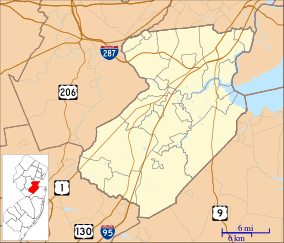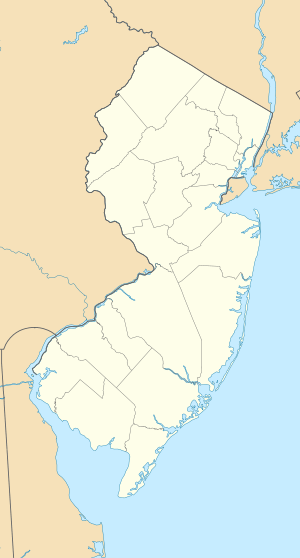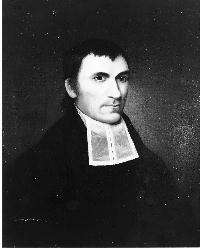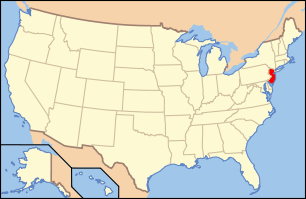Old Queens
|
Old Queen's | |
|
Winter at Old Queen's, the oldest building at Rutgers, built between 1809-1825. | |
   | |
| Location | New Brunswick, New Jersey |
|---|---|
| Coordinates | 40°29′57.72″N 74°26′50.88″W / 40.4993667°N 74.4474667°WCoordinates: 40°29′57.72″N 74°26′50.88″W / 40.4993667°N 74.4474667°W |
| Built | 1809–1823 |
| Architect | McComb, John,Jr. |
| Architectural style | Federal |
| NRHP Reference # | 76001164[1] |
| Significant dates | |
| Added to NRHP | May 11, 1976 |
| Designated NHL | May 11, 1976[2] |
Old Queen's is the oldest extant building at Rutgers University and is the symbolic heart of the university's campus in New Brunswick in Middlesex County, New Jersey in the United States. Rutgers, the Eighth-oldest college in the United States, was founded in 1766 during the American colonial period as Queen's College a decade before the start of American Revolution. Queen's College was named for Charlotte of Mecklenburg-Strelitz, the daughter of a German duke who became the queen consort of British king George III. Old Queen's is located on a six-acre hilltop city block bounded by Somerset Street, Hamilton Street, College Avenue and George Street that was previously an apple orchard. Donated to the college in 1807 by James Parker, Jr., this city block become known the Queen's Campus and is the historic core of the university. Because of this, by metonymy, the name "Old Queen's" came to be used as a reference to Rutgers College and is often invoked as an allusive reference to the university or to its administration.
Designed by American architect John McComb, Jr., who also designed New York City's city hall, the cornerstone of Old Queen's was laid in 1809 by the college's third president, the Rev. Ira Condict. Due to financial constraints, construction was not completed until 1823. In its early days, Old Queen's provided instruction space for lectures, student and faculty housing, as well as space for a college library and chapel that was shared by three institutions simultaneously: the College, its Grammar School (today, Rutgers Preparatory School), and the New Brunswick Theological Seminary. Today, Old Queen's houses the university's administration including the office of its president and governing boards.
Old Queen's is regarded by architectural experts as one of the finest examples of Federal architecture. Old Queens was placed on the National Register of Historic Places on May 11, 1976 and is listed as a National Historical Landmark.[3][4] The entire Queen's campus was included on the State and National registers in 1973.[5]
History
Early history (1766–1808)

Chartered on 10 November 1766, Queen's College was initially a small, private liberal arts college affiliated with the Dutch Reformed church founded "for the education of youth in the learned languages, liberal and useful arts and sciences, and especially in divinity; preparing them for the ministry and other good offices."[6][7][8] It is the eighth-oldest college in the United States and one of the nine Colonial Colleges founded before the American Revolution.[9][10] Queen's College was named for Charlotte of Mecklenburg-Strelitz, the daughter of a German duke who became the queen consort of British king George III. The college first held its classes in a tavern called "The Sign of the Red Lion" on the corner of Nielson and Albany Streets in New Brunswick, and later at a building on George Street in city's current business district, before moving the college to the hilltop where they would begin to build Old Queen's in 1809.
During the Revolution the hilltop where Old Queen's was built was the site of a redoubt where Alexander Hamilton, then an artillery captain commanding sixty men of the New York Provincial Company of Artillery, placed his cannons to cover the retreat of George Washington's forces after the British occupation of New York. After the British victory in taking Fort Washington in November 1776, Washington's forces retreated across New Jersey and into Pennsylvania. Hamilton's battery protected the forces as they crossed the Raritan River and passing through New Brunswick in 1776. British forces commanded by Lieutenant General Lord Cornwallis under orders from Lieutenant General William Howe, 5th Viscount Howe pursued Washington as far as New Brunswick.[11]
The hill belonged to John Parker, a prominent merchant from nearby Perth Amboy and was the site of an apple orchard. His heirs, including James Parker, Jr. (1776–1868), a local merchant and political figure, donated this orchard to the trustees of Queen's College (later renamed Rutgers) in 1808.[12] James Parker, Jr., a graduate of Columbia College (A.B. 1793) in New York, was a member of the New Jersey General Assembly, and later became a trustee of Queen's and later Rutgers College starting in 1812 and serving until his death in 1868. The college, which had closed in 1795 due to financial reasons, reopened in 1807 after a long fundraising campaign led by the Rev. Ira Condict (the school's third president, pro tempore) and the Rev. John Henry Livingston (the college's fourth president and founder of the New Brunswick Theological Seminary) with direct support from the Dutch Reformed Church's Synod of New York. The funds would be appropriated to build a permanent home for Queen's College, its grammar school (which remained open for the years the college closed), and Livingston's theological seminary which was permanently relocated to New Brunswick from New York.
Construction (1808-1825)

The trustees hired New York architect John McComb, Jr. (1763–1853) to design and oversee the construction of Old Queen's. McComb was known for his designs of the Cape Henry Light (1792) in Chesapeake Bay, and for Montauk Point Lighthouse (1796) and Station Eatons Neck Lighthouse (1798) at the eastern end of Long Island, and for several New York City landmarks including Gracie Mansion (1799), Hamilton Grange (1802), New York City Hall (1803), and St. John's Chapel (1803, demolished 1918). He would subsequently design Lower Manhattan's Castle Clinton (1808) and Alexander Hall at Princeton Theological Seminary (1815)
The cornerstone for Old Queens was laid on 27 April 1809 by Queen's College's president, the Rev. Ira Condict.[13][14] Due to the young college's financial difficulties, the building was not completed until 1825.[13][14] Classes began within the completed portions of the building as early as 1811 for Queen's College (now Rutgers University), Queen's College Grammar School (now Rutgers Preparatory School), and the New Brunswick Theological Seminary. The New Brunswick Theological Seminary moved in 1856 to a new 7 acres (2.8 ha) campus less than one-half mile away, as a result of overcrowding. The Grammar School had moved across the street several years earlier in 1830.[13][14]
In 1825, Colonel Henry Rutgers, an American Revolutionary War Hero and philanthropist from New York City gave the fledgling Queens College a $5,000 bond and a bell. The Trustees renamed the institution in honor of Colonel Rutgers.[13][14] The bell, known as the Old Queens Bell, was hung in the cupola of Old Queens to chime the passing of classes.[13] It remains there today, and is rung on special occasions, such as at Commencement exercise in May and in recognition of athletic teams who have won national conferences.[15] The cupola was donated by Stephen Van Rensellaer in 1825.[14]
Use
Initially, the first floor of Old Queens served as classrooms where recitation was held, and the second floor housed the college's chapel and library. The wings on each side of the structure served as living quarters for the faculty of the College. At the time, with no dormitories (until 1890), students at Rutgers found housing within rooming houses and other off-campus locations throughout New Brunswick.[14]
Today, Old Queens houses the offices of the university president and other top administration.
The gate outside Old Queens is the subject of a Rutgers legend. It is said that a Rutgers student should only walk through the gate on two days: convocation and graduation. One who passes through the gate on any other day during his/her undergraduate studies is said to be doomed to stay for an extra year or not even graduate.
Architecture
Constructed of ashlar brownstone in the front and sides and of local field stone in the rear, the façade of Old Queens incorporates symmetry and balance typical of Federal style architecture, and classical motifs such as Doric pilasters, and low-height pediments (or tympanum or gables) resembling those on ancient Greek and Roman temples typical to the Early American period.
Old Queens boasts its original handmade glass windowpanes. The lower floor windows are 12x8, with 16x12 on the second and 12x12 third floors. In each of the gables, circular windows, typical to Federal architecture are present.
A cupola erected in 1825, topped by a weathervane, houses the Old Queens Bell donated by Colonel Henry Rutgers.
Queen's Campus
Old Queen's is the oldest building and the centerpiece of the six extant building which constitute the Queen's Campus. The historic core of the university, it contains the university's oldest buildings. While the Old Queen's building obtained a discrete separate listing on the National Register of Historic Places for landmark status in 1976, the entire six-acre campus with these six remaining buildings was included together as one historic site on the New Jersey Register of Historic Places on January 29, 1973, and on the National Register of Historic Places on July 2, 1973.[5] These six buildings are:
- Old Queen's (built 1809–1823)
- Van Nest Hall (1845)
- Daniel S. Schanck Observatory (1865)
- Geology Hall (1872)
- Kirkpatrick Chapel (1873)
- Winants Hall (1890)
A seventh building, the former "President's House" (built in 1841), was demolished in 1948 after damage sustained during a hurricane. Used as the residence of the college's president in the nineteenth century, it was later used as a fine arts building before it was razed.
The Old Queens campus is accessed through four gateways, the Henry Rutgers Baldwin Gateway (erected 1901) on College Avenue, named for Henry Rutgers Baldwin (Class of 1849), the Class of 1883 Memorial Gateway (erected in 1904) at the corner of George and Somerset Streets, the Class of 1882 Gateway (erected 1907) at the corner of Somerset Street and College Avenue, and the Class of 1902 Memorial Gateway (erected in 1904) on Hamilton Street leading to the Voorhees Mall and the academic buildings on Rutgers University's College Avenue Campus. It is through this last gate that graduating seniors walk during Commencement exercises in May.[14]
Located in front of Old Queens, the Class of 1877 Cannon commemorates both the Rutgers-Princeton Cannon War and several alumni who have served in the United States military. As a tradition during commencement, those graduating break clay pipes over the cannon as a symbol of breaking ties with their "pipe dreams" of youth and embarking into adulthood.
References
- ↑ National Park Service (2007-01-23). "National Register Information System". National Register of Historic Places. National Park Service.
- ↑ "Old Queens, Rutgers University". National Historic Landmark summary listing. National Park Service. 2008-06-23.
- ↑ National Register of Historic Places - List of sites in Middlesex County, New Jersey accessed 10 September 2006.
- ↑ National Park Service: National Historical Landmarks Program accessed 10 September 2006.
- 1 2 The Queen's Campus (total of 7 buildings and grounds) is listed as SHPO ID# 1881, and NRHP Reference #73001113. See: New Jersey Department of Environmental Protection (NJ DEP) — Historic Preservation Office. New Jersey and National Registers of Historic Places — Middlesex County (Last Updated 5 April 2013), 7. Retrieved 5 September 2013.
- ↑ Hageman, Howard G. Two Centuries Plus: The Story of the New Brunswick Seminary. (Grand Rapids, MI: William B. Eerdsman Publishing Company, 1984), 13.
- ↑ Frusciano, Thomas J. (University Archivist). From "Seminary of Learning" to Public Research University: A Historical Sketch of Rutgers University. Rutgers University Libraries. Retrieved 17 August 2006.
- ↑ A Charter for Queen's College in New Jersey (1770) in Special Collections and University Archives, Archibald S. Alexander Library, Rutgers University, New Brunswick, New Jersey.
- ↑ Stoeckel, Althea. "Presidents, professors, and politics: the colonial colleges and the American revolution", Conspectus of History (1976) 1(3):45–56.
- ↑ Chapter XXIII. Education. § 13. Colonial Colleges in The Cambridge History of English and American Literature. (Cambridge: Cambridge University Press, 1907–1921; online edition, 2000).
- ↑ Barr, Michael C. and Wilkens, Edward. National Register of Historic Places Inventory Nomination Form for Queen's Campus at Rutgers University (1973). Retrieved 5 September 2013.
- ↑ Alumni Relations Newsletter
- 1 2 3 4 5 "Rutgers Through the Years Timeline". Rutgers University. Retrieved 2006-09-10.
- 1 2 3 4 5 6 7 "Paths to Historic Rutgers: A Self-Guided Tour". Rutgers University. Retrieved 2006-09-10.
- ↑ Tradition at www.scarletknights.com, accessed on 10 September 2006.
Books and printed materials
- Demarest, William Henry Steele. History of Rutgers College: 1776-1924. (New Brunswick, NJ: Rutgers College, 1924).
- History of Rutgers College: or an account of the union of Rutgers College, and the Theological Seminary of the General Synod of the Reformed Dutch Church. Prepared and published at the request of several trustees of the College, by a trustee. (New York: Anderson & Smith, 1833).
- McCormick, Richard P. Rutgers: a Bicentennial History. (New Brunswick, NJ: Rutgers University Press, 1966).
- Schmidt, George P. Princeton and Rutgers: The Two Colonial Colleges of New Jersey. (Princeton, NJ: Van Nostrand, 1964).
External links
| Wikimedia Commons has media related to Old Queens, Rutgers University. |

